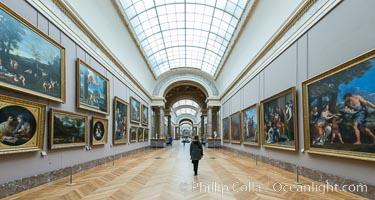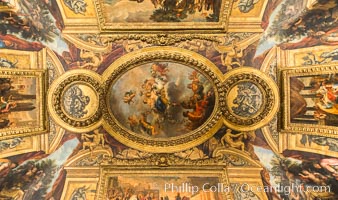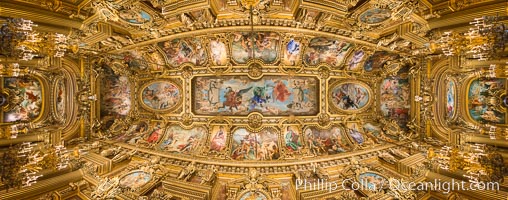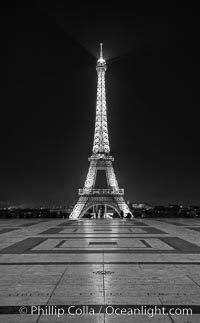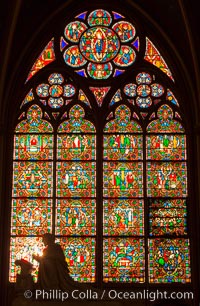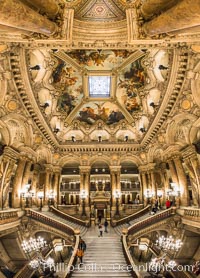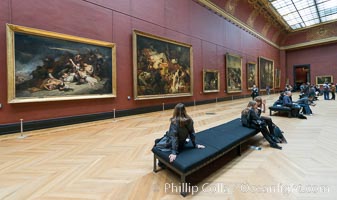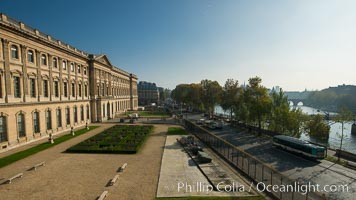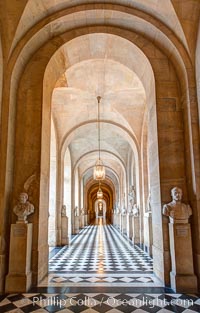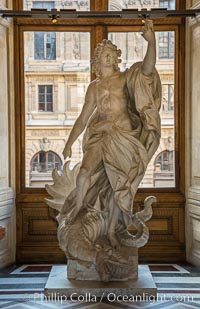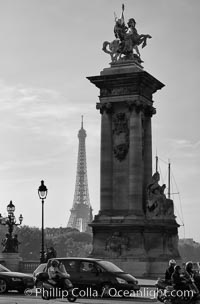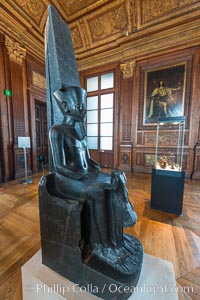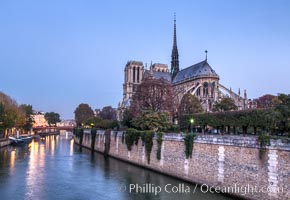
River Seine and Notre Dame Cathedral at Sunrise. Notre Dame de Paris (""Our Lady of Paris""), also known as Notre Dame Cathedral or simply Notre Dame, is a historic Roman Catholic Marian cathedral on the eastern half of the Ile de la Cite in the fourth arrondissement of Paris, France. Widely considered one of the finest examples of French Gothic architecture and among the largest and most well-known churches in the world ever built, Notre Dame is the cathedral of the Catholic Archdiocese of Paris.
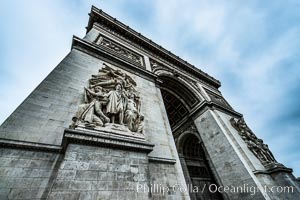
Arc de Triomphe. The Arc de Triomphe (Arc de Triomphe de l'Etoile) is one of the most famous monuments in Paris. It stands in the centre of the Place Charles de Gaulle (originally named Place de l'Etoile), at the western end of the Champs-Elysees. The Arc de Triomphe (in English: ""Triumphal Arch"") honors those who fought and died for France in the French Revolutionary and the Napoleonic Wars, with the names of all French victories and generals inscribed on its inner and outer surfaces. Beneath its vault lies the Tomb of the Unknown Soldier from World War I. The monument was designed by Jean Chalgrin in 1806, and its iconographic program pitted heroically nude French youths against bearded Germanic warriors in chain mail. It set the tone for public monuments, with triumphant patriotic messages. The monument stands 50 metres (164 ft) in height, 45 m (148 ft) wide and 22 m (72 ft) deep.
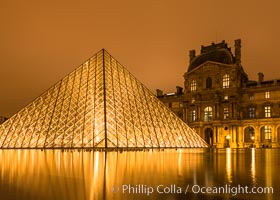
The Louvre Pyramid at Night, Pyramide du Louvre, large glass and metal pyramid in the main courtyard (Cour Napoleon) of the Louvre Palace (Palais du Louvre) in Paris
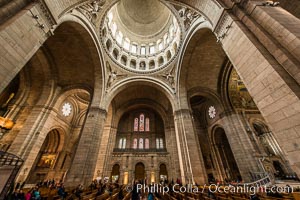
Sacre-Coeur Basilica. The Basilica of the Sacred Heart of Paris, commonly known as Sacre-Coeur Basilica, is a Roman Catholic church and minor basilica, dedicated to the Sacred Heart of Jesus, in Paris, France. A popular landmark, the basilica is located at the summit of the butte Montmartre, the highest point in the city.
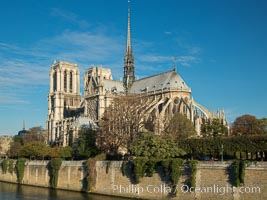
Notre Dame de Paris. Notre Dame de Paris (""Our Lady of Paris""), also known as Notre Dame Cathedral or simply Notre Dame, is a historic Roman Catholic Marian cathedral on the eastern half of the Ile de la Cite in the fourth arrondissement of Paris, France. Widely considered one of the finest examples of French Gothic architecture and among the largest and most well-known churches in the world ever built, Notre Dame is the cathedral of the Catholic Archdiocese of Paris.
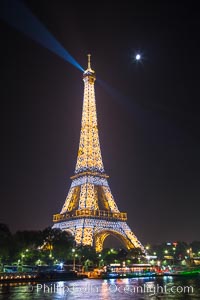
River Seine, Full Moon and Eiffel Tower at night, Paris. La Tour Eiffel. The Eiffel Tower is an iron lattice tower located on the Champ de Mars in Paris, named after the engineer Gustave Eiffel, who designed the tower in 1889 as the entrance arch to the 1889 World's Fair. The Eiffel tower is the tallest structure in Paris and the most-visited paid monument in the world
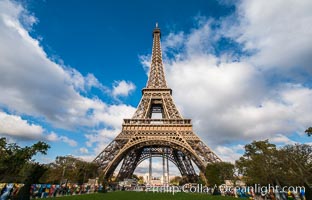
La Tour Eiffel, The Eiffel Tower is an iron lattice tower located on the Champ de Mars in Paris, named after the engineer Gustave Eiffel, who designed the tower in 1889 as the entrance arch to the 1889 World's Fair. The Eiffel tower is the tallest structure in Paris and the most-visited paid monument in the world
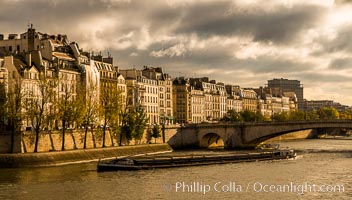
River Seine, barge and Ile Saint-Louis, sunrise, Paris. Ile Saint-Louis, is one of two natural islands in the Seine river, in Paris, France. The island is named after King Louis IX of France (Saint Louis). The island is connected to the rest of Paris by bridges to both banks of the river and by the Pont Saint Louis to the Ile de la Cite.
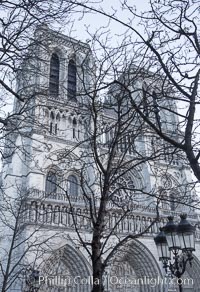
Notre Dame Cathedral, trees and streetlamp, west facade, Paris. Notre Dame de Paris (""Our Lady of Paris""), also known as Notre Dame Cathedral or simply Notre Dame, is a historic Roman Catholic Marian cathedral on the eastern half of the Ile de la Cite in the fourth arrondissement of Paris, France. Widely considered one of the finest examples of French Gothic architecture and among the largest and most well-known churches in the world ever built, Notre Dame is the cathedral of the Catholic Archdiocese of Paris.
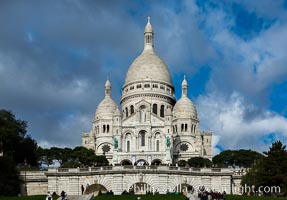
Sacre-Coeur Basilica. The Basilica of the Sacred Heart of Paris, commonly known as Sacre-Coeur Basilica, is a Roman Catholic church and minor basilica, dedicated to the Sacred Heart of Jesus, in Paris, France. A popular landmark, the basilica is located at the summit of the butte Montmartre, the highest point in the city.
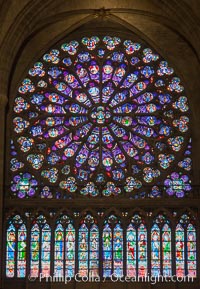
Notre Dame de Paris. Notre Dame de Paris (""Our Lady of Paris""), also known as Notre Dame Cathedral or simply Notre Dame, is a historic Roman Catholic Marian cathedral on the eastern half of the Ile de la Cite in the fourth arrondissement of Paris, France. Widely considered one of the finest examples of French Gothic architecture and among the largest and most well-known churches in the world ever built, Notre Dame is the cathedral of the Catholic Archdiocese of Paris.
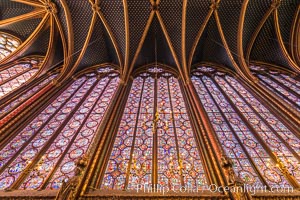
La Sainte-Chapelle, The Holy Chapel, is one of the only surviving buildings of the Capetian royal palace on the Ile de la Cite in the heart of Paris, France. It was commissioned by King Louis IX of France to house his collection of Passion Relics, including the Crown of Thorns - one of the most important relics in medieval Christendom.
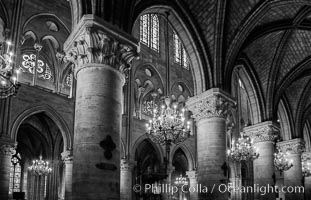
Notre Dame de Paris. Notre Dame de Paris (""Our Lady of Paris""), also known as Notre Dame Cathedral or simply Notre Dame, is a historic Roman Catholic Marian cathedral on the eastern half of the Ile de la Cite in the fourth arrondissement of Paris, France. Widely considered one of the finest examples of French Gothic architecture and among the largest and most well-known churches in the world ever built, Notre Dame is the cathedral of the Catholic Archdiocese of Paris.
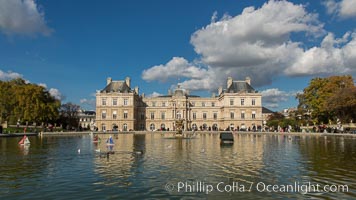
Jardin du Luxembourg. The Jardin du Luxembourg, or the Luxembourg Gardens, is the second largest public park in Paris located in the 6th arrondissement of Paris, France. The park is the garden of the French Senate, which is itself housed in the Luxembourg Palace.
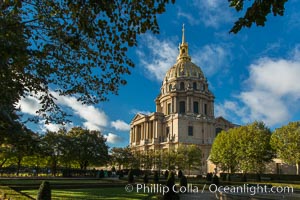
Les Invalides, officially known as L'Hotel national des Invalides (The National Residence of the Invalids), is a complex of buildings in the 7th arrondissement of Paris, France, containing museums and monuments, all relating to the military history of France, as well as a hospital and a retirement home for war veterans, the building's original purpose.
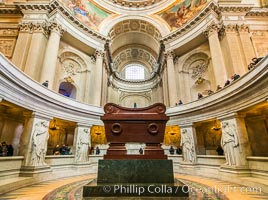
Tomb of Napolean Bonaparte in Les Invalides. Les Invalides, officially known as L'Hotel national des Invalides (The National Residence of the Invalids), is a complex of buildings in the 7th arrondissement of Paris, France, containing museums and monuments, all relating to the military history of France, as well as a hospital and a retirement home for war veterans, the building's original purpose.
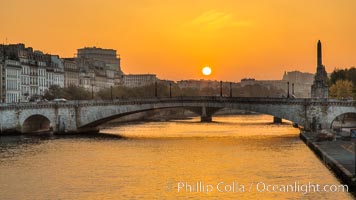
Ile Saint-Louis, is one of two natural islands in the Seine river, in Paris, France. The island is named after King Louis IX of France (Saint Louis). The island is connected to the rest of Paris by bridges to both banks of the river and by the Pont Saint Louis to the Ile de la Cite.
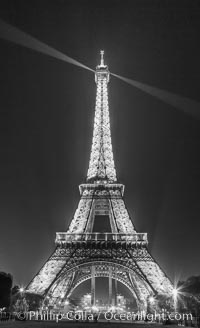
La Tour Eiffel. The Eiffel Tower is an iron lattice tower located on the Champ de Mars in Paris, named after the engineer Gustave Eiffel, who designed the tower in 1889 as the entrance arch to the 1889 World's Fair. The Eiffel tower is the tallest structure in Paris and the most-visited paid monument in the world
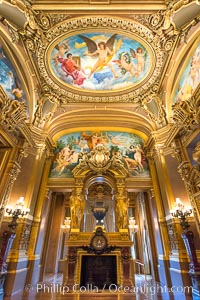
Opera de Paris, Paris Opera, or simply Opera, is the primary opera company of Paris. It was founded in 1669 by Louis XIV as the Academie d'Opera.
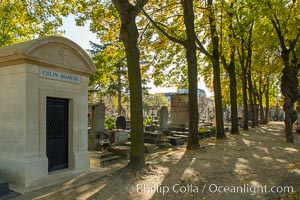
Cimetiere du Montparnasse. Montparnasse Cemetery is in the Montparnasse quarter of Paris, part of the city's 14th arrondissement.
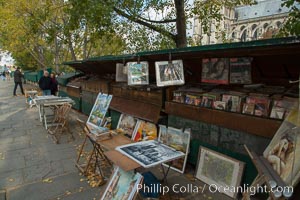
Art Seller along La Rive Gauche, the Left Bank, Paris. La Rive Gauch, the Left Bank, is the southern bank of the river Seine in Paris. Here the river flows roughly westward, cutting the city in two: looking downstream, the southern bank is to the left, and the northern bank (or Rive Droite) is to the right.
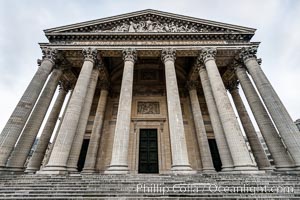
Pantheon. The Pantheon is a building in the Latin Quarter in Paris. It was originally built as a church dedicated to St. Genevieve and to house the reliquary chasse containing her relics but now functions as a secular mausoleum containing the remains of distinguished French citizens.
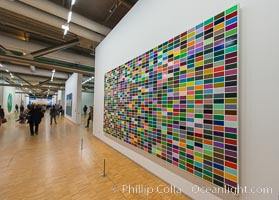
Musee National d'Art Moderne, in Centre Georges Pompidou. Centre Georges Pompidou (also known as the Pompidou Centre) houses the Bibliotheque publique d'information, a vast public library, the Musee National d'Art Moderne which is the largest museum for modern art in Europe, and IRCAM, a centre for music and acoustic research.
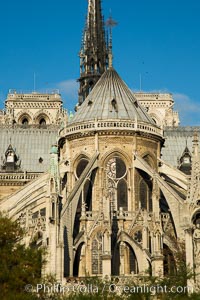
Notre Dame de Paris. Notre Dame de Paris (""Our Lady of Paris""), also known as Notre Dame Cathedral or simply Notre Dame, is a historic Roman Catholic Marian cathedral on the eastern half of the Ile de la Cite in the fourth arrondissement of Paris, France. Widely considered one of the finest examples of French Gothic architecture and among the largest and most well-known churches in the world ever built, Notre Dame is the cathedral of the Catholic Archdiocese of Paris.
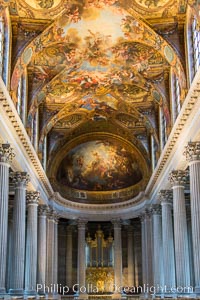
Royal Chapel of Versailles, dedicated to Saint Louis, patron saint of the Bourbons, the chapel was consecrated in 1710. It was here that Louis XVI of France was wed to Marie-Antoinette. The ceiling represents God the Father in His Glory Bringing to the World the Promise of Redemption and was painted by Antoine Coypel.
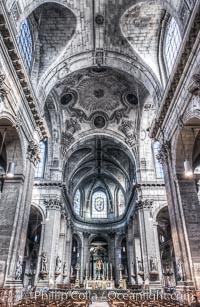
Eglise Saint-Sulpice. Saint-Sulpice is a Roman Catholic church in Paris, France, on the east side of the Place Saint-Sulpice, in the Luxembourg Quarter of the VIe arrondissement. At 113 metres long, 58 metres in width and 34 metres tall, it is only slightly smaller than Notre-Dame and thus the second largest church in the city.
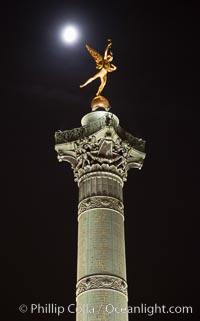
July Column in the Place de la Bastille. The Place de la Bastille is a square in Paris, where the Bastille prison stood until the 'Storming of the Bastille' and its subsequent physical destruction between 14 July 1789 and 14 July 1790 during the French Revolution. The square straddles 3 arrondissements of Paris, namely the 4th, 11th and 12th. The July Column (Colonne de Juillet) which commemorates the events of the July Revolution (1830) stands at the center of the square
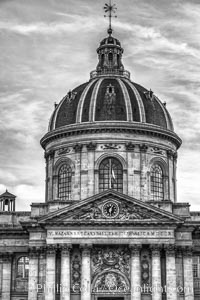
Institut de France. The Institut de France is a French learned society, grouping five academies, the most famous of which is the Academie francaise.
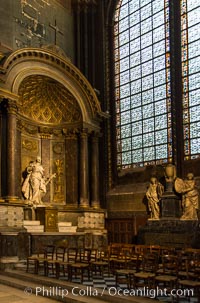
Abbey of Saint-Germain-des-Pres. The Benedictine Abbey of Saint-Germain-des-Pres, just beyond the outskirts of early medieval Paris, was the burial place of Merovingian kings of Neustria. The Abbey was founded in the 6th century by the son of Clovis I, Childebert I.
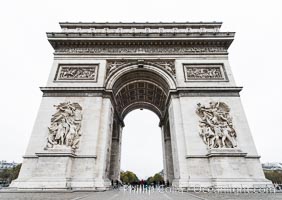
Arc de Triomphe. The Arc de Triomphe (Arc de Triomphe de l'Etoile) is one of the most famous monuments in Paris. It stands in the centre of the Place Charles de Gaulle (originally named Place de l'Etoile), at the western end of the Champs-Elysees. The Arc de Triomphe (in English: ""Triumphal Arch"") honors those who fought and died for France in the French Revolutionary and the Napoleonic Wars, with the names of all French victories and generals inscribed on its inner and outer surfaces. Beneath its vault lies the Tomb of the Unknown Soldier from World War I. The monument was designed by Jean Chalgrin in 1806, and its iconographic program pitted heroically nude French youths against bearded Germanic warriors in chain mail. It set the tone for public monuments, with triumphant patriotic messages. The monument stands 50 metres (164 ft) in height, 45 m (148 ft) wide and 22 m (72 ft) deep.
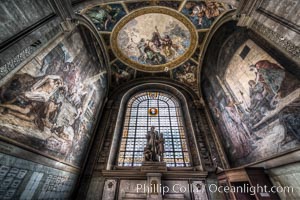
Eglise Saint-Sulpice. Saint-Sulpice is a Roman Catholic church in Paris, France, on the east side of the Place Saint-Sulpice, in the Luxembourg Quarter of the VIe arrondissement. At 113 metres long, 58 metres in width and 34 metres tall, it is only slightly smaller than Notre-Dame and thus the second largest church in the city.
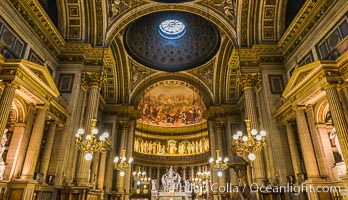
Eglise de la Madeleine, a Roman Catholic church in the 8th arrondissement of Paris, designed in its present form as a temple to the glory of Napoleon's army.
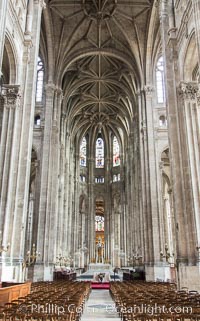
Eglise Saint-Eustache. The Church of St Eustace, Paris a church in the 1st arrondissement of Paris. Situated at the entrance to Paris's ancient markets (Les Halles) and the beginning of rue Montorgueil, St Eustace's is considered a masterpiece of late Gothic architecture.
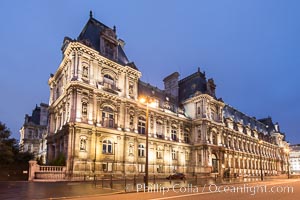
Hotel de Ville. The Hotel de Ville in Paris, France, is the building housing the City of Paris's administration. Standing on the place de l'Hotel de Ville (formerly the place de Greve) in the city's IVe arrondissement, it has been the location of the municipality of Paris since 1357.
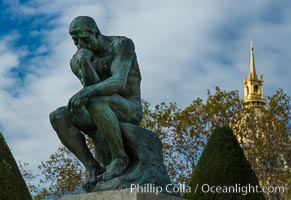
The Thinker (Le Penseur) is a bronze sculpture on marble pedestal by Auguste Rodin. now in the Musee Rodin in Paris. It depicts a man in sober meditation battling with a powerful internal struggle. It is often used to represent philosophy.
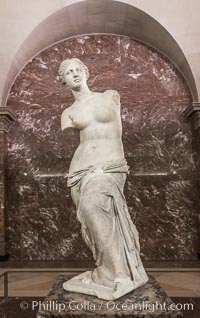
Aphrodite of Milos, Aphrodite tes Melou, better known as the Venus de Milo, is an ancient Greek marble statue and one of the most famous works of ancient Greek sculpture. Created sometime between 130 and 100 BC, it is believed to depict Aphrodite, the Greek goddess of love and beauty (Venus to the Romans).
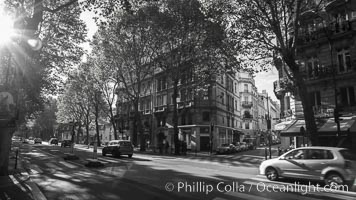
Latin Quarter. The Latin Quarter of Paris is an area in the 5th and parts of the 6th arrondissement of Paris. It is situated on the left bank of the Seine, around the Sorbonne known for student life, lively atmosphere and bistros.
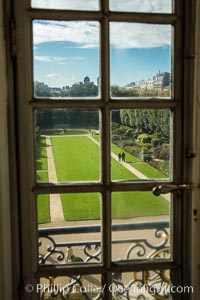
Musee Rodin, in Paris, France, is a museum dedicated to the works of the French sculptor Auguste Rodin.
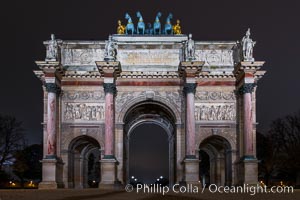
Arc de Triomphe du Carrousel. The Arc de Triomphe du Carrousel is a triumphal arch in Paris, located in the Place du Carrousel on the site of the former Tuileries Palace. It was built between 1806 and 1808 to commemorate Napoleon's military victories of the previous year.

Jardin du Luxembourg. The Jardin du Luxembourg, or the Luxembourg Gardens, is the second largest public park in Paris located in the 6th arrondissement of Paris, France. The park is the garden of the French Senate, which is itself housed in the Luxembourg Palace.
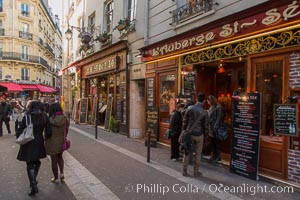
Latin Quarter. The Latin Quarter of Paris is an area in the 5th and parts of the 6th arrondissement of Paris. It is situated on the left bank of the Seine, around the Sorbonne known for student life, lively atmosphere and bistros.
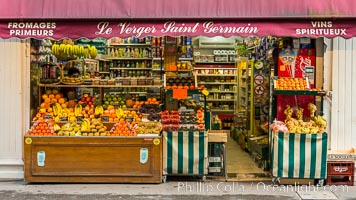
Latin Quarter. The Latin Quarter of Paris is an area in the 5th and parts of the 6th arrondissement of Paris. It is situated on the left bank of the Seine, around the Sorbonne known for student life, lively atmosphere and bistros.
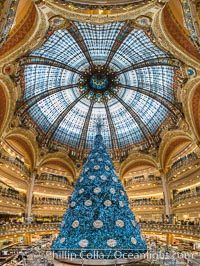
Christmas tree display at les Galeries Lafayette. The Galeries Lafayette is an upmarket French department store company located on Boulevard Haussmann in the 9th arrondissement of Paris.
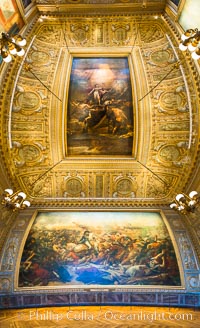
The Battle of the Nile, also known as the Battle of Aboukir Bay, in French as the Bataille d'Aboukir, panaramic photo showing wall and ceiling detail.
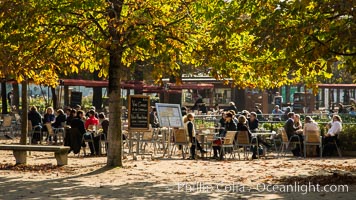
Jardin des Tuileries. The Tuileries Garden is a public garden located between the Louvre Museum and the Place de la Concorde in the 1st arrondissement of Paris. created by Catherine de Medicis as the garden of the Tuileries Palace in 1564.
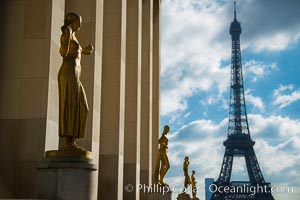
Trocadero. The Trocadero, site of the Palais de Chaillot, is an area of Paris, France, in the 16th arrondissement, across the Seine from the Eiffel Tower.
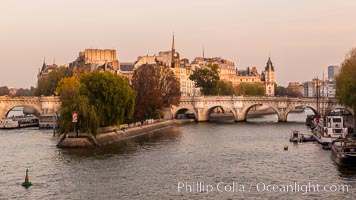
Ile de la Cite, one of two remaining natural islands in the Seine within the city of Paris It is the center of Paris and the location where the medieval city was refounded.
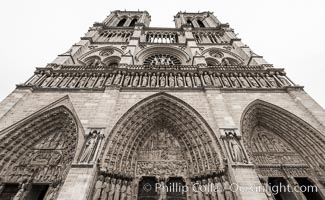
Notre Dame de Paris. Notre Dame de Paris (""Our Lady of Paris""), also known as Notre Dame Cathedral or simply Notre Dame, is a historic Roman Catholic Marian cathedral on the eastern half of the Ile de la Cite in the fourth arrondissement of Paris, France. Widely considered one of the finest examples of French Gothic architecture and among the largest and most well-known churches in the world ever built, Notre Dame is the cathedral of the Catholic Archdiocese of Paris.
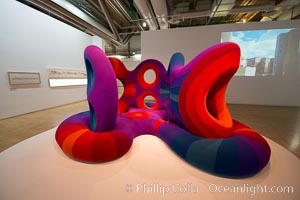
Musee National d'Art Moderne, in Centre Georges Pompidou. Centre Georges Pompidou (also known as the Pompidou Centre) houses the Bibliotheque publique d'information, a vast public library, the Musee National d'Art Moderne which is the largest museum for modern art in Europe, and IRCAM, a centre for music and acoustic research.
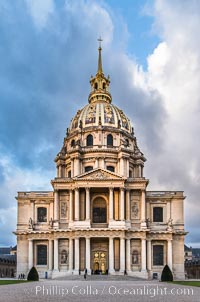
Les Invalides, officially known as L'Hotel national des Invalides (The National Residence of the Invalids), is a complex of buildings in the 7th arrondissement of Paris, France, containing museums and monuments, all relating to the military history of France, as well as a hospital and a retirement home for war veterans, the building's original purpose.
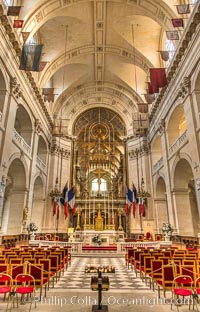
Les Invalides, officially known as L'Hotel national des Invalides (The National Residence of the Invalids), is a complex of buildings in the 7th arrondissement of Paris, France, containing museums and monuments, all relating to the military history of France, as well as a hospital and a retirement home for war veterans, the building's original purpose.

Ile Saint-Louis, is one of two natural islands in the Seine river, in Paris, France. The island is named after King Louis IX of France (Saint Louis). The island is connected to the rest of Paris by bridges to both banks of the river and by the Pont Saint Louis to the Ile de la Cite.
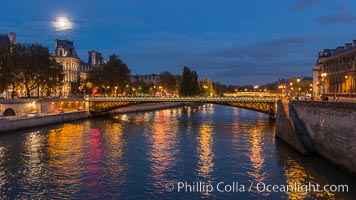
Ile Saint-Louis, is one of two natural islands in the Seine river, in Paris, France. The island is named after King Louis IX of France (Saint Louis). The island is connected to the rest of Paris by bridges to both banks of the river and by the Pont Saint Louis to the Ile de la Cite.
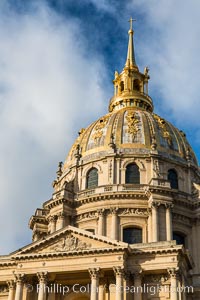
Les Invalides, officially known as L'Hotel national des Invalides (The National Residence of the Invalids), is a complex of buildings in the 7th arrondissement of Paris, France, containing museums and monuments, all relating to the military history of France, as well as a hospital and a retirement home for war veterans, the building's original purpose.
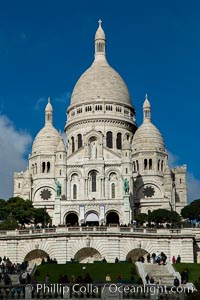
Sacre-Coeur Basilica. The Basilica of the Sacred Heart of Paris, commonly known as Sacre-Coeur Basilica, is a Roman Catholic church and minor basilica, dedicated to the Sacred Heart of Jesus, in Paris, France. A popular landmark, the basilica is located at the summit of the butte Montmartre, the highest point in the city.
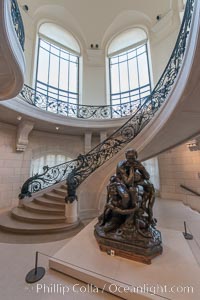
Petit Palais, (Small Palace), is a museum in Paris, France. Built for the Universal Exhibition in 1900 to Charles Girault's designs, it now houses the City of Paris Museum of Fine Arts (musee des beaux-arts de la ville de Paris).
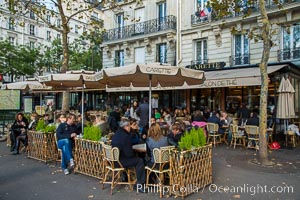
Trocadero. The Trocadero, site of the Palais de Chaillot, is an area of Paris, France, in the 16th arrondissement, across the Seine from the Eiffel Tower.
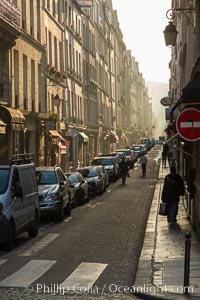
Rue de Ile Saint-Louis, early morning, Paris. Ile Saint-Louis is one of two natural islands in the Seine river, in Paris, France. The island is named after King Louis IX of France (Saint Louis). The island is connected to the rest of Paris by bridges to both banks of the river and by the Pont Saint Louis to the Ile de la Cite.
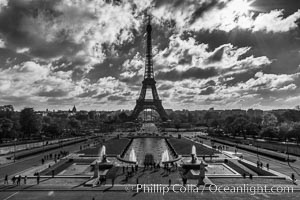
Eiffel Tower and the Trocadero, clouds and sunshine, Paris. The Trocadero, site of the Palais de Chaillot, is an area of Paris, France, in the 16th arrondissement, across the Seine from the Eiffel Tower.
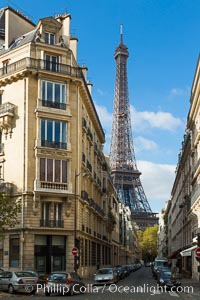
La Tour Eiffel. The Eiffel Tower is an iron lattice tower located on the Champ de Mars in Paris, named after the engineer Gustave Eiffel, who designed the tower in 1889 as the entrance arch to the 1889 World's Fair. The Eiffel tower is the tallest structure in Paris and the most-visited paid monument in the world
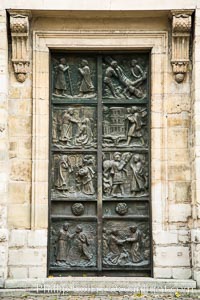
Eglise Saint-Pierre de Montmartre. The Church of Saint Peter of Montmartre is the lesser known of the two main churches on Montmartre in Paris, the other being the 19th-century Sacre-Coeur Basilica. Historically, however, it has the greater claim to fame, since, according to the earliest biography of Saint Ignatius Loyola, the church is the location at which the vows were taken that led to the founding of the Society of Jesus
